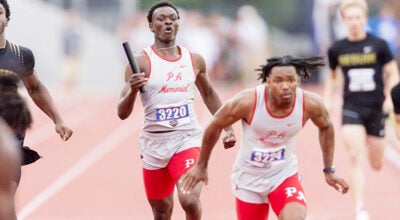The Local Olympic Movement: America’s Golden Babe
Published 10:02 pm Tuesday, July 19, 2016

- Babe Didrikson, second from right, and Evelyne Hall, far right, run a close 80-meter hurdles final in the 1932 Summer Olympic Games in Los Angeles. Race film revealed Didrikson won by inches. (The Associated Press)
This is the first of a seven-part series on Olympic participants with ties to greater Port Arthur. Sunday: Boxers Morris Carona and Dick Menchaca
Mildred Ella Didrikson qualified for the 1932 Los Angeles Olympics at the right time.
For one, she was a rare talent of multidisciplinary athleticism who was about to display her prowess to the world for the first time.
Secondly, she didn’t have to travel overseas to do it. The United States had the rare distinction of hosting both the Winter and Summer Games in the same year. (Lake Placid, N.Y., played host to the winter festivities, and no American city would welcome the Games again until Squaw Valley, Calif., in 1960.)
Meanwhile, Sidney Bowman of Hammond, La., was gearing for his second Olympiad in track and field, hoping to improve on his bronze-medal performance in the triple jump from four years earlier in Amsterdam. Like Jim Thorpe, the Mississippi-born Bowman was a professional, although in baseball, competing against amateurs, having played in the St. Louis Cardinals’ farm team in Iowa in the summer of 1931 and batting .415 while still an undergraduate at LSU. Baseball commissioner Kennesaw Mountain Landis, though, declared all underclassmen off-limits to major-league teams.
•
Born as the fourth of seven children to Norwegian immigrants in Port Arthur on June 26, 1911, Didrikson moved with her family to Beaumont at age 4. She repeated the eighth grade before attending Beaumont High School, but she dropped out when she moved to Dallas to play basketball. Her first job after high school, in fact, was secretary for the Employers’ Casualty Insurance Co. of Dallas, just so she could play for the company’s industrial team. She led the Golden Cyclones, as the team was known, to the 1931 AAU championship.
By this time, she also excelled in bowling, diving and roller-skating. She claimed she earned the nickname Babe, after Babe Ruth, because she hit five home runs in a baseball game.
But the entire country took notice of its future golden girl when she represented the country in the 1932 AAU women’s track and field championships, which were then the trials for the U.S. Olympic team, in Evanston, Ill. She competed in eight of 10 events and won six of them (finishing tied for first with Jean Shiley in the high jump).
Didrikson was first outright in the 80-meter hurdles, javelin, long jump, shot put and baseball throw. Only the high jump, hurdles and javelin were contested in the Olympics then.
The men’s AAU championships took place in Stanford, California, and Bowman was building on an impressive track resume himself. Having set a national interscholastic record of 49 feet, 1 inch, four years earlier, he edged Rolland Romero by 1 inch to win the triple jump, then known as the hop-step-and-jump, at 48 feet, 11¼ inches, or 14.91 meters. He set an LSU school record of 49-7½ and also was a running back for the Tigers’ football team.
•
The Summer Games were held July 30 through Aug. 14 in Los Angeles, the only city to bid on the festival. Many athletes and nations could not afford to pay for the trip to California due in large part to the Great Depression, but 37 nations were still represented.
The women’s javelin throw was held on the second day of the games. American Nan Gindele set a world record of 46.745 meters (153 feet, 4 inches) in the Central AAU championships a month earlier and was expected to be a serious contender for Olympic gold. But she failed to break 40 meters in Los Angeles and finished fifth.
Didrikson, all 5-feet-7 and 115 pounds of her, won the javelin throw on July 31 with an Olympic record of 43.69 meters (143-3¾). Germany’s Ellen Braumuller was second at 43.5.
None of the 80-meter hurdles medalists in the 1930 world championships competed in Los Angeles, opening the door for Didrikson to bring home the gold.
On Aug. 3, Didrikson and compatriot Simone Schaller set a world record of 11.8 seconds in the first heat of the 80-meter hurdles. Another American, Evelyne Hall, won her heat in 12.0 seconds.
That set up a close duel in the final round the next day. Both Didrikson and Hall turned in a time of 11.7 seconds, but film showed that Didrikson won by inches.
On Aug. 7, Shiley and Didrikson would go at it again in the high jump. Again, Didrikson and another American would match a world record at 1.65 meters, or 5 feet, 5 inches. A jump-off was ordered, and both cleared 1.67 meters, just 0.75 inch higher, on the first attempt. Didrikson, however, was penalized for “diving,” or jumping head-first, giving the gold to Shiley. Didrikson said she jumped in the same style throughout the competition.
Bowman failed to even match his Amsterdam performance, taking seventh in the triple jump. He was the second-highest finishing American to Sol Furth, who also did not medal.
•
By 1933, Bowman, then about 26 years old, became a resident of Port Arthur. He and his first wife Martha Ferguson owned a nightclub in the town that became popular after Prohibition was repealed, and Bowman worked as a bartender. It’s not clear how long Bowman lived in Port Arthur, but he moved back to Louisiana following his divorce to work as a government tobacco inspector under Gov. Huey P. Long and was later appointed state fire marshal.
Bowman died April 28, 1986.
After nearly becoming a three-time Olympic gold medalist, Didrikson toured with her All-Americans basketball team and took up golf, her excellence in which she is best remembered. She won 41 events on the LPGA Tour, including four as an amateur, including 10 majors.
She married wrestler George Zaharias in 1938 and died in Galveston on Sept. 27, 1956, of cancer at age 45. They were residents of Tampa, Fla., at the time of her death, and they had no children.
Golf courses in Port Arthur and Tampa, Fla., are named in Babe Zaharias’ honor, as well as a park and museum in Beaumont. A made-for-television movie, “Babe,” starring real-life couple and “Webster” stars Susan Clark and Alex Karras, aired in 1975.
•
Sources: Sports-Reference.com; Babe Didrikson Zaharias Museum; Museum of the Gulf Coast; Louisiana Sports Hall of Fame; Wikipedia
•
I.C. Murrell: 721-2435. Twitter: @ICMurrellPANews






